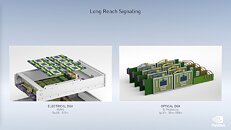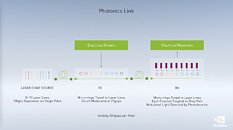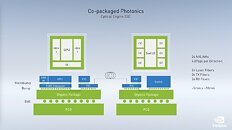Friday, December 18th 2020

NVIDIA is Preparing Co-Packaged Photonics for NVLink
During its GPU Technology Conference (GTC) in China, Mr. Bill Dally—NVIDIA's chief scientist and SVP of research—has presented many interesting things about how the company plans to push the future of HPC, AI, graphics, healthcare, and edge computing. Mr. Dally has presented NVIDIA's research efforts and what is the future vision for its products. Among one of the most interesting things presented was a plan to ditch the standard electrical data transfer and use the speed of light to scale and advance node communication. The new technology utilizing optical data transfer is supposed to bring the power required to transfer by a significant amount.
The proposed plan by the company is to use an optical NVLink equivalent. While the current NVLink 2.0 chip uses eight pico Joules per bit (8 pJ/b) and can send signals only to 0.3 meters without any repeaters, the optical replacement is capable of sending data anywhere from 20 to 100 meters while consuming half the power (4 pJ/b). NVIDIA has conceptualized a system with four GPUs in a tray, all of which are connected by light. To power such a setup, there are lasers that produce 8-10 wavelengths. These wavelengths are modulated onto this at a speed of 25 Gbit/s per wavelength, using ring resonators. On the receiving side, ring photodetectors are used to pick up the wavelength and send it to the photodetector. This technique ensures fast data transfer capable of long distances.And that is not even all of it. To integrate everything, NVIDIA needs to combine it with chip packaging technology. Pictured below is a setup where the GPU and memory combination sits on a silicon interposer, which itself is placed on top of an organic package. This organic package is connected to the photonic integrated circuit (PIC). Further, there is an electrical interface chip (EIC) that converts the electrical signals coming from the GPU, using resonators, to optical signals. Optical interconnect needs a similarly built switch on its side.Using these techniques, NVIDIA says that in the future there could be systems with 1000s of interconnected GPUs, each of which talks to another using a speed of light. It is only a matter of time before the technology reaches the market, however, there are no guarantees as this is only a research project for now.
Sources:
NVIDIA YouTube, via Hardwareluxx.de
The proposed plan by the company is to use an optical NVLink equivalent. While the current NVLink 2.0 chip uses eight pico Joules per bit (8 pJ/b) and can send signals only to 0.3 meters without any repeaters, the optical replacement is capable of sending data anywhere from 20 to 100 meters while consuming half the power (4 pJ/b). NVIDIA has conceptualized a system with four GPUs in a tray, all of which are connected by light. To power such a setup, there are lasers that produce 8-10 wavelengths. These wavelengths are modulated onto this at a speed of 25 Gbit/s per wavelength, using ring resonators. On the receiving side, ring photodetectors are used to pick up the wavelength and send it to the photodetector. This technique ensures fast data transfer capable of long distances.And that is not even all of it. To integrate everything, NVIDIA needs to combine it with chip packaging technology. Pictured below is a setup where the GPU and memory combination sits on a silicon interposer, which itself is placed on top of an organic package. This organic package is connected to the photonic integrated circuit (PIC). Further, there is an electrical interface chip (EIC) that converts the electrical signals coming from the GPU, using resonators, to optical signals. Optical interconnect needs a similarly built switch on its side.Using these techniques, NVIDIA says that in the future there could be systems with 1000s of interconnected GPUs, each of which talks to another using a speed of light. It is only a matter of time before the technology reaches the market, however, there are no guarantees as this is only a research project for now.




26 Comments on NVIDIA is Preparing Co-Packaged Photonics for NVLink
Bill Daily..
Accountants love him!
The optical fiber usually utilized in networking is usually glass and a bit more fragile. Also transceivers for those super high speed comms are usually quite a bit more expensive. Only recently have 10GbE SFP+s come down in price, and the max 16 Gbps is barely going to cut it for 4k60HDR... that is if there is no overhead at all.
Photonics for off-chip communications probably are the future, but they've just been much more expensive and difficult to implement vs new advancements in metal interconnects. There will come a tipping point, assuming metal cannot scale any further.
There is also the problem of existing infrastructure (something which limits replacing HDMI or DP). Just look at the number of people pushing and clawing for 10GbE, instead of fiber SFP+.Ideally (IMO), we'd see the original Thunderbolt. Lightpeak, which only Sony used (though was codeveloped by Intel and Sony).
Copper for power, optical for data. Better to use the more ideal mediums for each respective task.
That being said, you'll probably get your wish if DP-VESA ever gets a foothold in the consumer TV market. HDMI is limited by their adherence to their connector form factor. DP just ditched it for DP2.0, which uses the USB-C connector for it's highest bitrates. The older DP plugs will still chug along at lower bitrates, but they are no longer the future.
Light (photons) can be used for data transfer, you need emitter and receiver. That's it. It's very fast and advanced, if built well.
Idea is, also, ages old - because it's relatively simple idea to come by. Implementation is the question. Would I like to see optronic of photonic computer or whatever you like to call them? Sure! Would be great!
This is, however, something like optical cable between GPUs (they don't go much in depth, so this is just simplification) instead of copper one.
It will mean literally nothing to me (and 99% people here), as we have only one GPU in computer. For super-computers, it will probably mean something-to-lot, depending on implementation.
No, Jensen didn't discover light, similar as he didn't discover 50-year old ray-tracing...
To be fair, the more one technology is used, the faster it will advance. But we're probably many years away from optical computing, which would be super-great.
In addition to the speed and power advantages, I think it could also represent some interesting prospects in the mobile market. I mean, let's say there is the possibility that ultra low power PC's could run on solar power. Wouldn't it be interesting if you could skip the whole inefficient conversion process to electrons and directly feed your PC photons? Could be pretty neat.
achicourt.fr/wp-content/uploads/2018/12/fibre-optique2-1080x675.jpg
Now wireless optical communication exists for very short distances or/and space and military application but since it requires powerfull laser emitters ( for relatively long distance ) etc you can imagine that this is very far away from making it into your living room from an economical and even physical perspective .
Simply, optics provide better spectrum efficiency.
Even though this idea has been floating around for at least 10 years now, this is way more detailed than they usually come out with. So I'm cautiously optimistic.
Yes radio frequency obeys to the same laws of physics with light considering both are parts of electromagnetic radiation spectrum but nope they are not the same thing given precisely their different wavelengths ( which indicate their energy ) make them have totally different properties . For example Radio wavelenght is very high which in returns makes it's frequency ( read energy ) very low ( as compared to the rest of the electromagnetic spectrum www.justscience.in/wp-content/uploads/2017/05/electromagneticspectrum.jpg ) so this means it will be more easily absorbed by a given body compared to a signal with much higher frequency ( read energy ) which will traverse the same body . Anyways again this is off topic since nobody mentioned RF !
The topic was to know if fiber optic can be considered as wireless which of course the answer is no , even though as i already mentioned wireless transmition of high volume of information through powerfull light signal ( read very short wavelenghts on the electromagnetic spectrum ) exist but only for very particular applications that are far from making it in our living rooms .